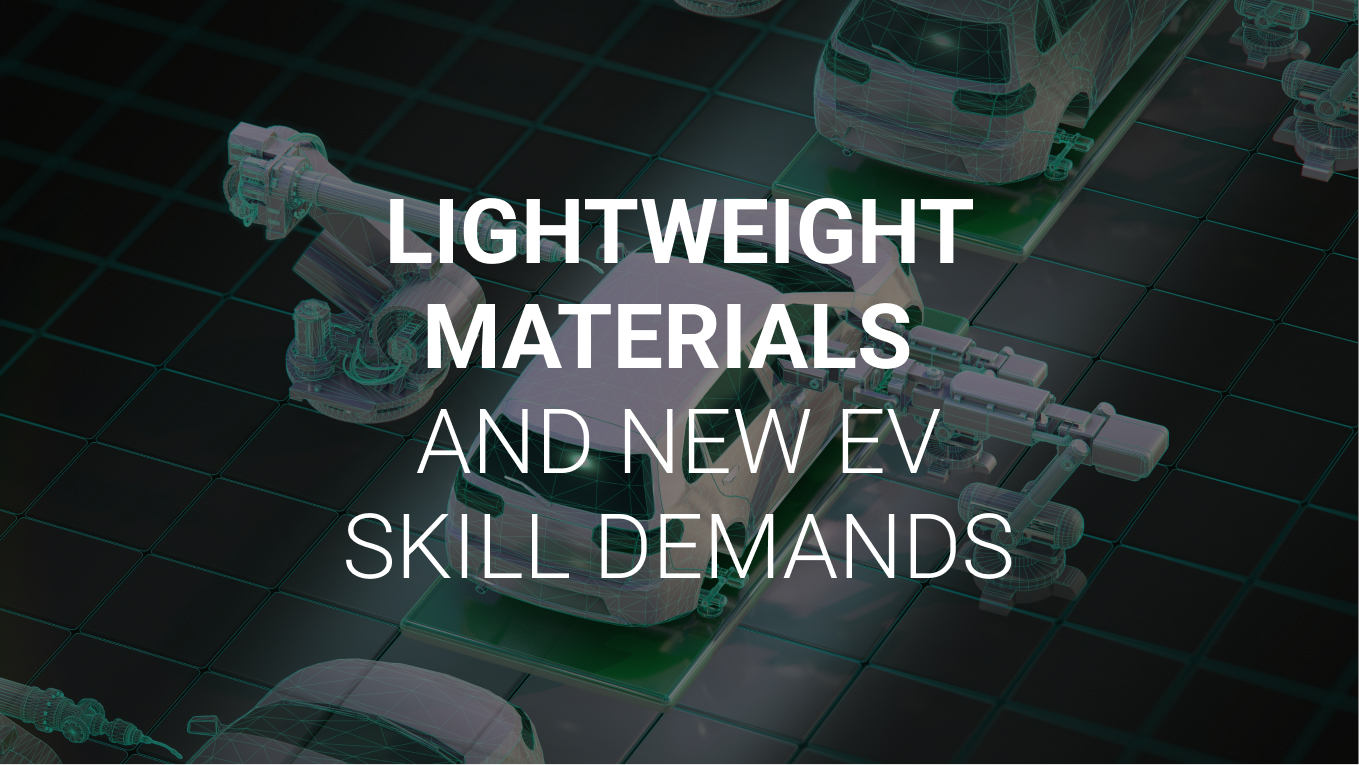The Shift to Electric Vehicles: Technology, Lightweight Materials and New EV Skill Demands
 20.11.2025
20.11.2025
 5 mins to read
5 mins to read

What if the craft of body repair is no longer defined by steel panels and weld-lines, but by voltage systems, software diagnostics, and composite bonding? The UK automotive sector is undergoing a structural shift. Electrification, lightweight materials and advanced manufacturing are redrawing the repair landscape. Aluminium and composite structures are becoming the standard, while high-voltage systems and new safety protocols redefine workshop competence. And all this is not a distant future. It is already unfolding in UK workshops and manufacturing plants. Read on to discover how technology, materials and evolving skill requirements are reshaping automotive repair.
New energy vehicles: the industrial and technological backdrop
The UK government’s Advanced Manufacturing Sector Plan, published 23 June 2025, sets out a target to nearly double annual business investment in advanced manufacturing – including automotive, batteries and advanced materials. Moreover, the UK’s advanced manufacturing sector – including automotive and advanced materials – is supported by up to £4.3 billion in public funding and aims to achieve an investment growth of £39 billion annually by 2035. For the automotive sector, the new DRIVE35 programme commits £2.5 billion over the next decade to support zero-emission vehicle manufacturing and R&D. What starts in manufacturing does not end there. It is now reshaping how workshops operate and how the repair supply chain functions.
The rise of vehicle lightweight materials
As zero-emission vehicle platforms proliferate, material strategies are shifting. The business.gov.uk “Advanced Manufacturing” sector page emphasises that the UK’s automotive industry (worth ~£83.4 billion) is accelerating the shift to net-zero mobility and advanced materials. From the repair workshop perspective, the use of aluminium alloys, extrusions, bonded composite panels and multi-material structures introduces a new era of repair challenges. Among the most troublesome are different joining methods, corrosion risks, material recognition and replacement options. Here is a comparative overview of material choices and their workshop implications:
| Material Choice | Benefits | Repair / Workshop Implications |
| Aluminium | Significant vehicle weight saving; mature recycling flows. | Specialist welding, rivets or bonding needed; galvanic corrosion to manage. |
| Advanced Composite Material | Excellent stiffness-to-weight; high freedom of form. | Often replacement rather than traditional repair; new inspection regimes required. |
Electric vehicles and the new safety paradigm
Workshop repair of electric vehicles (EVs) and hybrids introduces substantially different risk profiles. The UK regulator Health and Safety Executive (HSE) guidance notes that electric/hybrid vehicles may carry up to 650 V dc. They can pose hazards such as stored energy, explosion risk, unexpected movement and high-voltage components. Consequently, bodyshop operations and technician training must evolve accordingly. The qualifications landscape is moving towards specific high-voltage EV competencies, diagnostics of battery packs, and new repair protocols.
Key skill areas emerging for electric vehicle repair technicians include:
- Safe isolation, testing and re-energisation of high-voltage systems, as defined in the IMI National Occupational Standard IMIEV04;
- High-voltage system diagnostics, including removal and reinstatement of battery components, as delivered through IMI Level 4 EV qualifications offered by approved training centres such as Autotech Training;
- Preparation and safe isolation of high-voltage systems in heavy electric and hybrid vehicles, as covered by the recently listed IMI Level 2 Technical Specialist in Preparing Heavy Electric/Hybrid Vehicles for Repair;
- Participation in EV-certification programmes that integrate structured professional development, ongoing assessment and competency renewal, as reflected in training frameworks used by providers such as REVAMP.
Material choice, circularity and regulatory pressure
Material innovations in the automotive industry are increasingly linked to the requirements of sustainable development and the circular economy. The UK’s ‘UK Net Zero Research & Innovation Framework Delivery Plan: Progress Report 2022-2025’ references new routes for resource efficiency, recycled content (including aluminium) and advanced circular-material solutions. For the repair sector, this means ensuring material traceability, accurately identifying panel/sub-structure materials, verifying actual repair versus replacement decisions, and aligning with OEM expectations regarding repair strategy. Repairers must anticipate manufacturer service bulletins, material certification and possibly recycled-material compliance.
What this means in practice and recommended actions in the world of EVs.
For bodyshops, fleet servicers and training-providers, the evolving material and EV ecosystem demands proactive adaptation.
Recommended steps for EV vehicles include:
- Integrate EV-specific training modules (high-voltage isolation, battery incident response) and ensure technicians hold documented competencies.
- Equip workshops with dedicated bays or infrastructure for aluminium and composite repair — including contamination control, correct bonding tools and manufacturer-approved complexity.
- Establish supplier networks that include aluminium-structure panels, composite-repair kits or OEM-approved remanufacturers for non-standard materials.
- Review government funding and support opportunities (e.g., DRIVE35/Advanced Manufacturing Plan) to upgrade tooling, retrain staff and adapt workshop infrastructure.
By viewing the transition as an opportunity rather than a threat, repair operations can align themselves with the next generation of electric cars.
Ready for the next EV automotive chapter
The convergence of electrification, advanced materials and heightened regulatory/safety demands is reshaping automotive repair. The UK’s industrial strategy, material-innovation programmes and regulator guidance all point in the same direction: greater technical precision, broader materials knowledge and stronger safety frameworks. For bodyshops and repair networks ready to invest in this shift, the future isn’t just about keeping pace. It is about defining the standard for quality, safety and capability in the EV era.
Sources:
https://www.business.gov.uk/campaign/invest-in-great/advanced-manufacturing
https://www.gov.uk/government/publications/advanced-manufacturing-sector-plan
https://www.nextmsc.com/report/automotive-aluminium-market-mc3014
https://www.compositesworld.com/articles/composites-end-markets-automotive-2025
https://www.hse.gov.uk/mvr/topics/electric-hybrid.htm
https://autotechtraining.co.uk/electric-and-hybrid-vehicle-level-4-2
https://tide.theimi.org.uk/learn/qualifications/610_4569_X
https://www.revamptraining.co.uk/uploads/1/2/6/2/126201574/imi_level4_diagnosis.pdf






